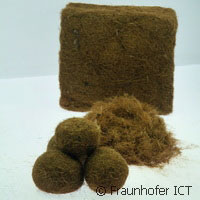| Mar 08, 2013 | |
Insulating buildings with seaweed |
|
| (Nanowerk News) Electricity, gas and oil are more expensive than ever, so intelligent energy management has never been more important than today. But what does energy efficiency actually mean? What are the benefits - for the environment and our own pockets? Must we accept drastic limitations in order to consume less energy? | |
| Buildings account for 40% of Europe's energy use and a third of its greenhouse gas emissions. If we want to transform our society into an energy-efficient and decarbonised one, energy-intelligent buildings will have to play a vital role. Many new building proposals include the provision of energy efficient and cooling technologies such as solar thermal heating systems, combined heat and power (CHP), heat pumps and thermal energy storage. All of these innovations are commercially available today. There is another, cost-effective option available however: environmentally friendly insulation. | |
 For many coastal dwellers, seaweed washed up on the shore is nothing but a nuisance. But what does that have to do with buildings and heating? German researchers have found that this raw material has the potential to keep buildings well insulated. Together with industry partners, researchers have succeeded in turning this substance into a viable insulation material. Throughout autumn, winter and spring, Mediterranean beaches are littered with little balls of seaweed from the Posidonia oceanica plant, more commonly known as Neptune grass. Although this natural material is regarded as a waste product and generally ends up as landfill, this readily abundant and renewable material is in fact far too valuable to be thrown away. The seaweed displays a variety of characteristics that make it of interest to the building trade, such as virtual non-flammability and resistance to mould. It can be used as an insulating material without the need for chemical additives, and can be applied between the rafters of pitched roofs and against interior walls. Seaweed fibres act as a buffer, absorbing water vapour and releasing it again without impairing its own ability to keep the building insulated. And with a salt content of just 0.5 to 2 percent, Neptune balls can be used to produce insulation material that will not rot away. But how exactly is seaweed processed into a building material? This is a difficult task, as it is not easy to remove adherent sand from the Neptune balls. In addition, individual fibres tend to catch easily on anything, including one another, and are quick to form new clumps both during processing and later when being blown into spaces in need of insulation. However, new methods for turning Neptune balls into viable insulating material have been developed by the Fraunhofer Institute for Chemical Technology ICT, in collaboration with other industrial partners. The project partners' aim was to produce an insulating material capable of being stuffed or blown into the required space without difficulty. |
|
| "Shaking the Neptune balls proved the best way of making sure we end up with fibres that are as long as possible and free of sand," says Dr. Gudrun Gräbe from Fraunhofer ICT. By carefully breaking up the clumps, Gräbe and her team were able to find the best way of acquiring fibres. Once all sand has been removed from the balls, a conveyor belt delivers them to the cutting mills, from where 1.5 to 2 centimetre fibres emerge undamaged and drop into plastic bags. | |
| The Fraunhofer Institute for Building Physics IBP in Holzkirchen found that the loose insulating material produced is capable of holding a considerable amount of energy - 2.502 joules per kilogram kelvin (J/kgK) - which is 20 percent higher than that of wood or wood products. This means that the fibrous material can keep buildings cool in hot weather, and shielding them from the heat during the day. An analysis was done, confirming how well Posidonia fibers insulate heat. "The material could be employed in construction at sufficient density to prevent it from collapsing in on itself. The density required was determined by the Materials Testing Office MPA NRW in Dortmund," says Gräbe. Research was done to find if this material was suitable health wise. The figures released by the eco-INSTITUTE in Cologne, revealed that this seaweed is 100 percent entirely free of extraneous or toxic matter, making it also particularly suitable for allergy sufferers. | |
| Finally another advantage of Neptune balls is that they are environmentally friendly - the entire manufacturing process requires very little energy. Neptune balls are harvested by hand and brought to Germany by sea from Tunisia or by road from Albania. | |
| The Posidonia fibres have already proved their worth in a range of new construction projects and renovations of existing buildings. There are now plans to develop solid, ecologically-sound sheets from this material in order to offer a comprehensive system for insulating roofs, exterior façades, interior walls and basement ceilings. Further studies on the material are being carried out by researchers from Fraunhofer Institute. In the meantime, a company called NeptuTherm e.K. has given its name to the new novel insulating material, and is already marketing and distributing it. |
| Source: Cordis |
